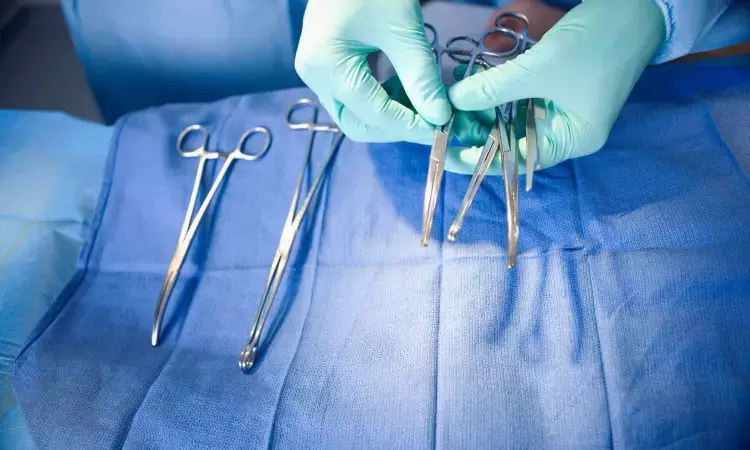- Home
- Medical news & Guidelines
- Anesthesiology
- Cardiology and CTVS
- Critical Care
- Dentistry
- Dermatology
- Diabetes and Endocrinology
- ENT
- Gastroenterology
- Medicine
- Nephrology
- Neurology
- Obstretics-Gynaecology
- Oncology
- Ophthalmology
- Orthopaedics
- Pediatrics-Neonatology
- Psychiatry
- Pulmonology
- Radiology
- Surgery
- Urology
- Laboratory Medicine
- Diet
- Nursing
- Paramedical
- Physiotherapy
- Health news
- Fact Check
- Bone Health Fact Check
- Brain Health Fact Check
- Cancer Related Fact Check
- Child Care Fact Check
- Dental and oral health fact check
- Diabetes and metabolic health fact check
- Diet and Nutrition Fact Check
- Eye and ENT Care Fact Check
- Fitness fact check
- Gut health fact check
- Heart health fact check
- Kidney health fact check
- Medical education fact check
- Men's health fact check
- Respiratory fact check
- Skin and hair care fact check
- Vaccine and Immunization fact check
- Women's health fact check
- AYUSH
- State News
- Andaman and Nicobar Islands
- Andhra Pradesh
- Arunachal Pradesh
- Assam
- Bihar
- Chandigarh
- Chattisgarh
- Dadra and Nagar Haveli
- Daman and Diu
- Delhi
- Goa
- Gujarat
- Haryana
- Himachal Pradesh
- Jammu & Kashmir
- Jharkhand
- Karnataka
- Kerala
- Ladakh
- Lakshadweep
- Madhya Pradesh
- Maharashtra
- Manipur
- Meghalaya
- Mizoram
- Nagaland
- Odisha
- Puducherry
- Punjab
- Rajasthan
- Sikkim
- Tamil Nadu
- Telangana
- Tripura
- Uttar Pradesh
- Uttrakhand
- West Bengal
- Medical Education
- Industry
Key risk factors for surgical site infection after abdominal hysterectomy

USA: A recent study published in the American Journal of Infection Control (AJIC) has described risk factors for surgical site infection after abdominal hysterectomy.
Findings from an analysis of more than 66,000 abdominal hysterectomies performed in New York hospitals revealed open surgery, obesity, diabetes, gynaecological cancer, and age under 45 risk factors for surgical site infection. The data can help inform surgical and clinical decisions to reduce post-operative infections.
“Improved understanding of patient-related, clinical, and surgical factors associated with SSI in hysterectomy, a common surgical procedure in the United States, could help to reduce infections and improve risk models,” said Boldtsetseg Tserenpuntsag, DrPH, Director - Data Unit, Bureau of Healthcare-Associated Infections, New York State Department of Health, and the lead author on the published study. “As far as we know, our findings are derived from the most comprehensive dataset to date, making them more generalizable as compared to previous studies on this subject.”
SSIs are infections that occur at a surgical incision site within 30 days after the incision is made. According to the Centers for Disease Control and Prevention, SSI accounts for 20% of all healthcare-associated infections (HAIs) and is associated with a 2-to 11-fold increase in the risk of mortality. SSI is also the most costly type of HAI with an estimated annual cost of $3.3 billion.
To identify the risk factors for SSI after abdominal hysterectomy, Dr. Tserenpuntsag, and colleagues used data reported in the National Healthcare Safety Network (NHSN) from 66,001 abdominal hysterectomies performed over four years at all acute care hospitals in New York State (166). They augmented these data with diagnosis codes available in administrative data.
Among the 66,001 procedures the researchers analyzed, 1,093 (1.66%) SSIs were reported. After adjusting for other risk factors, the analysis showed that patients with the following independent risk factors were significantly more likely to experience an SSI:
• Age under 45: Adjusted odds ratio (AOR) of 1.65 (age under 35) and 1.21 (age 35-44)
• Open laparotomic approach (i.e., not laparoscopic): AOR of 2.75
• Contaminated/dirty wound classification: AOR of 2.28
• Obesity (body mass index >30): AOR of 1.78
• Procedure time greater than 186 minutes: AOR of 1.78
• American Society of Anesthesia (ASA) score >3: AOR of 1.74
• Having gynaecological cancer: AOR of 1.54
• Having diabetes: AOR of 1.46
“Given the size and rigour of this analysis, the findings contribute meaningfully to our understanding of SSI, and should provide valuable information to enhance surgical planning and thereby help prevent post-surgical infections,” said Patricia Jackson, RN, MA, CIC, FAPIC, 2023 APIC president.
Reference:
Boldtsetseg Tserenpuntsag, Valerie Haley, Peggy Ann Hazamy, Robin Knab, Ernest J. Clement, Published:March 29, 2023 DOI:https://doi.org/10.1016/j.ajic.2023.01.016.
Dr Kamal Kant Kohli-MBBS, DTCD- a chest specialist with more than 30 years of practice and a flair for writing clinical articles, Dr Kamal Kant Kohli joined Medical Dialogues as a Chief Editor of Medical News. Besides writing articles, as an editor, he proofreads and verifies all the medical content published on Medical Dialogues including those coming from journals, studies,medical conferences,guidelines etc. Email: drkohli@medicaldialogues.in. Contact no. 011-43720751


